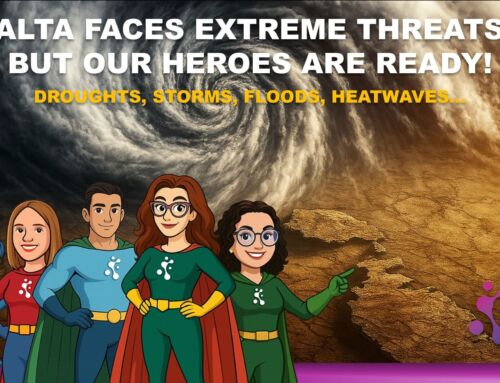In an interview on Rasimbras, a prime-time journalistic programme on TVMnews in April 2024, predictions were made about the end of the ongoing El Niño phenomenon, which had contributed to the record heat in 2023. The forecast suggested that the summer of 2024 would be less extreme in terms of heat, despite some criticism on social media. As the summer draws to a close, it appears that this forecast held true. Though El Niño persisted longer than expected, the World Meteorological Organization (WMO) declared its end in June 2024, and the summer was notably less severe than in 2023, with fewer intense heatwaves affecting Europe and Malta.
Cold Wave Impacts and Autumn Weather Patterns: A Maltese Perspective
As Europe braces for its first significant cold wave of the season, Malta remains vulnerable to the effects of such weather patterns, despite its geographical distance from colder regions. While not subjected to freezing conditions like those seen in central Europe, the cold waves that reach the Mediterranean often trigger atmospheric instability. This can result in powerful storms, heavy rainfall, and localised flooding, particularly in urban and coastal areas with insufficient drainage systems.
Mediterranean Influence on Cold Waves
The Mediterranean Sea plays a crucial role in mitigating the intensity of cold waves as they approach Malta. The interaction of cold continental air with the warmer Mediterranean atmosphere frequently leads to the development of thunderstorms and heavy downpours. While Malta does not experience the severe cold that other European regions face, it still endures notable drops in temperature, often accompanied by strong winds and stormy conditions.
These autumn cold fronts typically bring significant rainfall, posing flash flooding risks in areas such as Birkirkara, Burmarrad, Gzira, Marsa and Msida. These areas, with poor drainage infrastructure, are particularly prone to sudden inundation during heavy rain events.
Temperature Drops and Windy Conditions
Malta’s Mediterranean climate typically provides some protection against the harsher conditions experienced by mainland Europe. However, these cold outbreaks still result in noticeable temperature declines, typically ranging between 5–7°C, especially during the night. These cooler temperatures are often accompanied by strong winds, which can create significant disruptions to maritime activities and exacerbate the impact of rainfall through storm surges in low-lying coastal areas. The colder temperatures, although not extreme, mark a clear transition from Malta’s warmer climate to the more temperate and unsettled weather that characterises the autumn season.
Impact on Agriculture and Coastal Areas
The agricultural sector in Malta is particularly vulnerable to the heavy rains associated with autumn cold waves. Farmers often face challenges with waterlogged fields, which can damage crops and erode soil. This is especially concerning for citrus and vegetable crops, which form a key part of Malta’s agricultural economy. Coastal areas also face considerable risks. Strong winds can lead to coastal flooding, threatening homes, infrastructure, and businesses located in low-lying regions. Erosion remains a constant concern for the island’s coastlines, as storm surges exacerbate existing vulnerabilities.
Excessive Rainfall and Flooding in Malta
One of Malta’s most pressing autumn concerns is the risk of flooding. Like many regions in Europe, the island struggles to manage the large volumes of rain that can result from sudden storms. Urban areas with outdated drainage systems are especially susceptible to flash floods, and while there have been improvements in recent years, heavy rainfall continues to pose a significant threat.
As autumn progresses, the combination of heavy rain, strong winds, and inadequate drainage infrastructure could lead to a heightened risk of flooding. This poses significant risks not only to infrastructure but also to the local economy, which often suffers from the disruptions caused by these weather events.
The Role of Climate Change
The interview on Rasimbras also highlighted the role of climate change in shaping Malta’s weather patterns. As sea temperatures rise across the Mediterranean, the frequency and intensity of storms are expected to increase, contributing to more unpredictable weather in the future. While the summer of 2024 was relatively mild in comparison to 2023, the long-term trend points toward more severe weather events, including stronger storms, heavier rainfall, and increased coastal erosion.
With the Mediterranean warming at an accelerated rate, it is likely that autumn storms will become even more severe in the coming years. Rising sea levels further complicate this situation, presenting ongoing challenges to Malta’s coastal infrastructure and defences.
Preparing for Autumn and Beyond
Malta must continue to invest in robust infrastructure to cope with these weather events, particularly in urban areas prone to flooding. Strengthening coastal defences and improving drainage systems are essential steps to mitigate the risks posed by heavy rain and strong winds. Public awareness campaigns in coastal communities can also help reduce risks by ensuring that residents are prepared for adverse weather conditions.
Accurate weather forecasting and early warnings, as underscored in the Rasimbras interview, will remain critical to Malta’s ability to prepare for and respond to seasonal weather events. Proactive measures in forecasting will allow residents and businesses to take necessary precautions to avoid the worst impacts.
The summer of 2024 affirmed predictions of milder conditions compared to the extreme heat of 2023. However, as autumn progresses, Malta must remain vigilant in its preparations for colder weather patterns and the risks that accompany them. The island’s location in the Mediterranean exposes it to storms, heavy rainfall, and coastal flooding, even if it avoids the freezing conditions of northern Europe. Strengthening infrastructure, raising public awareness, and implementing climate adaptation strategies will be essential to ensure Malta’s resilience in the face of evolving weather patterns.






